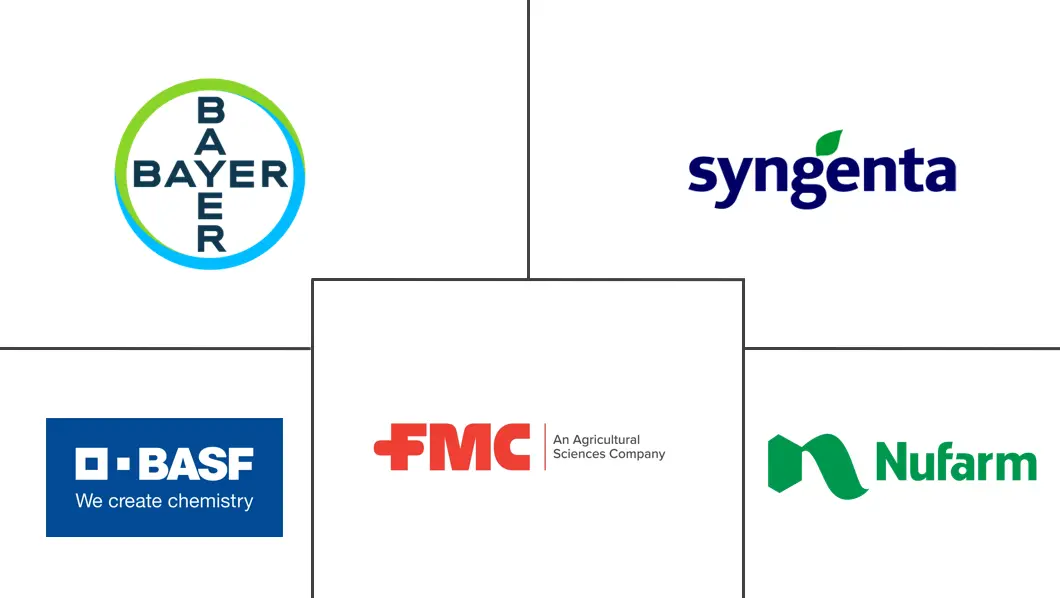Dicamba Herbicide Market Size and Share
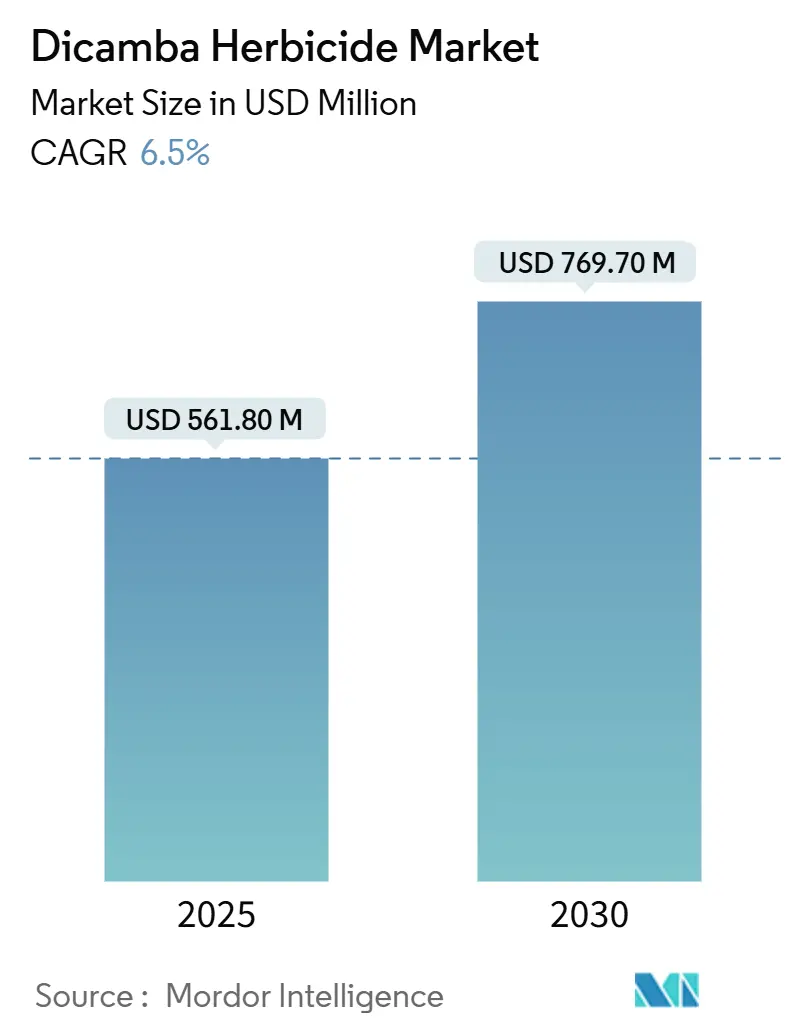
Dicamba Herbicide Market Analysis by Mordor Intelligence
The Dicamba Herbicide Market size is estimated at USD 561.80 million in 2025, and is expected to reach USD 769.70 million by 2030, at a CAGR of 6.5% during the forecast period (2025-2030).
Dicamba, a synthetic auxin herbicide, has gained prominence in agriculture due to increasing glyphosate resistance in weeds. When applied, dicamba can drift to surrounding areas, affecting non-target plant communities through exposure to low doses. This exposure directly impacts plant growth and phenotypes while indirectly influencing plant-herbivore interactions.
The emergence of glyphosate-resistant weeds has increased the demand for alternative herbicides such as dicamba. Dicamba effectively controls a wide range of broadleaf weeds, making it essential for farmers to manage resistant weed populations. According to the International Herbicide-Resistant Weed Database, 2024 data shows 534 unique cases (species x site of action) of herbicide-resistant weeds globally, encompassing 273 species (156 dicots and 117 monocots). These weeds have developed resistance to 21 of the 31 known herbicide sites of action and 168 different herbicides. The database documents herbicide-resistant weeds across 101 crops in 75 countries.
The Environmental Protection Agency (EPA) has approved new dicamba formulations with enhanced safety and effectiveness. These formulations demonstrate lower volatility, which reduces the potential for off-target damage. In October 2022, the EPA granted new registrations for two dicamba products and extended another product's registration until 2025. These registrations incorporated additional measures to control off-target movement and protect non-target crops and plants. States implemented further registration amendments throughout 2022 and 2023. State-specific amendments address local concerns and reduce risks by adapting dicamba product usage requirements to regional conditions. These customized regulations increase the adoption of dicamba products across different states. The regulatory framework and safety measures strengthen farmer confidence in dicamba application, as established protocols minimize potential risks. This increased confidence contributes to higher demand for dicamba products in the market.
Global Dicamba Herbicide Market Trends and Insights
Grains and Cereals Dominate the Market
The global population increases by 75 million annually, representing a 1.1% growth rate per year. The U.S. Census Bureau projects the world population to reach 9 billion by 2044, marking a 50% increase over 45 years. Meeting food demand for this growing population presents a significant challenge, particularly as available farmland decreases. The rise in weed infestations further reduces crop productivity. These factors drive the demand for crop protection chemicals, including dicamba herbicides, to ensure global food security. Dicamba herbicides have seen increased adoption worldwide as a pre-emergence herbicide in agriculture due to their effectiveness in controlling perennial weeds in cropland.
Cereal crops, including wheat, barley, and oats, are significant consumers of dicamba herbicides due to their effectiveness in controlling broadleaf weeds that compete with crops for nutrients, water, and sunlight. Dicamba functions by imitating the plant hormone auxin, which triggers abnormal growth patterns and ultimately destroys the weeds. FAOSTAT data indicates that the global wheat harvested area increased from 219.03 million hectares in 2022 to 220.4 million hectares in 2023. The expansion of wheat cultivation areas has led to increased risks of herbicide-resistant weeds. Farmers incorporate dicamba into integrated weed management programs to control resistant weed species and maintain effective weed population management.
According to a 2024 study by Washington University in St. Louis, 57% of weedy rice samples from the southeastern United States demonstrated resistance to imidazolinone (IMI) herbicides. The research analyzed 201 samples collected from fields across nine counties in Missouri, Arkansas, and Louisiana. The increasing prevalence of herbicide-resistant weeds has led farmers to rely more heavily on dicamba herbicides, which remain effective against resistant weed varieties. This effectiveness in maintaining crop yields and controlling weed populations continues to drive market growth.
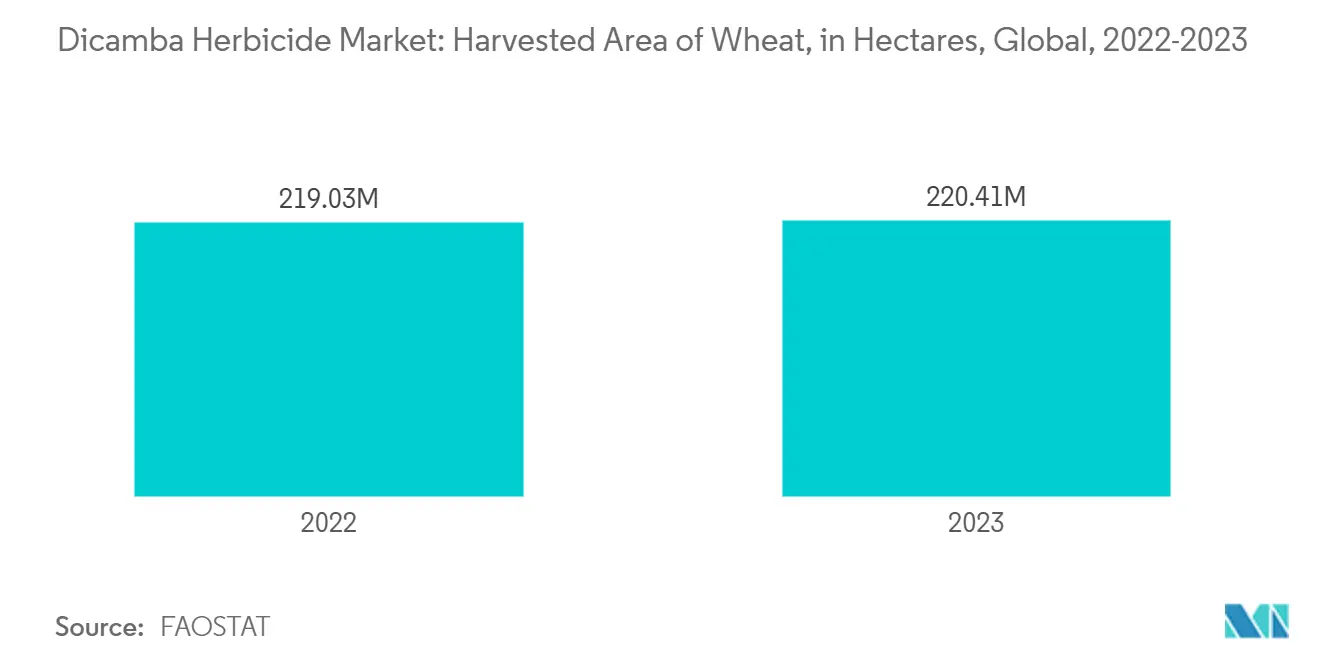
North America is Leading the market
North America is projected to reach the largest market for Dicamba herbicides during the forecast period. In North America, glyphosate is extensively used as a herbicide. The highest glyphosate usage in the United States occurs in Illinois, Iowa, Nebraska, Kansas, North Dakota, Minnesota, South Dakota, Texas, Indiana, and Missouri. The application volume of glyphosate-based herbicides (GBHs) in the United States has grown due to patent expiration, greater adoption of no-till farming practices, and the development of glyphosate-resistant crops. However, the emergence of glyphosate-resistant weeds has propelled the farmers to adopt dicamba as an alternative herbicide. In addition, glyphosate has been identified with carcinogenic characteristics by the International Agency for Research For Cancer. This, in turn, has created the demand for dicamba herbicide in the region, and the demand is projected to increase further during the forecast period.
The growth in United States corn and soybean production has driven increased dicamba herbicide usage. FAOSTAT data shows that corn production in the United States rose from 346.7 million metric tons in 2022 to 389.6 million metric tons in 2023. The expansion of corn production has led to greater herbicide-resistant weed populations. Dicamba effectively controls numerous broadleaf weeds commonly found in corn fields, making it a preferred solution for managing diverse weed populations. Furthermore, the development of dicamba-tolerant corn varieties enables farmers to apply dicamba directly to crops without causing damage. This advancement has expanded dicamba usage by providing an efficient weed management solution, driving market growth.
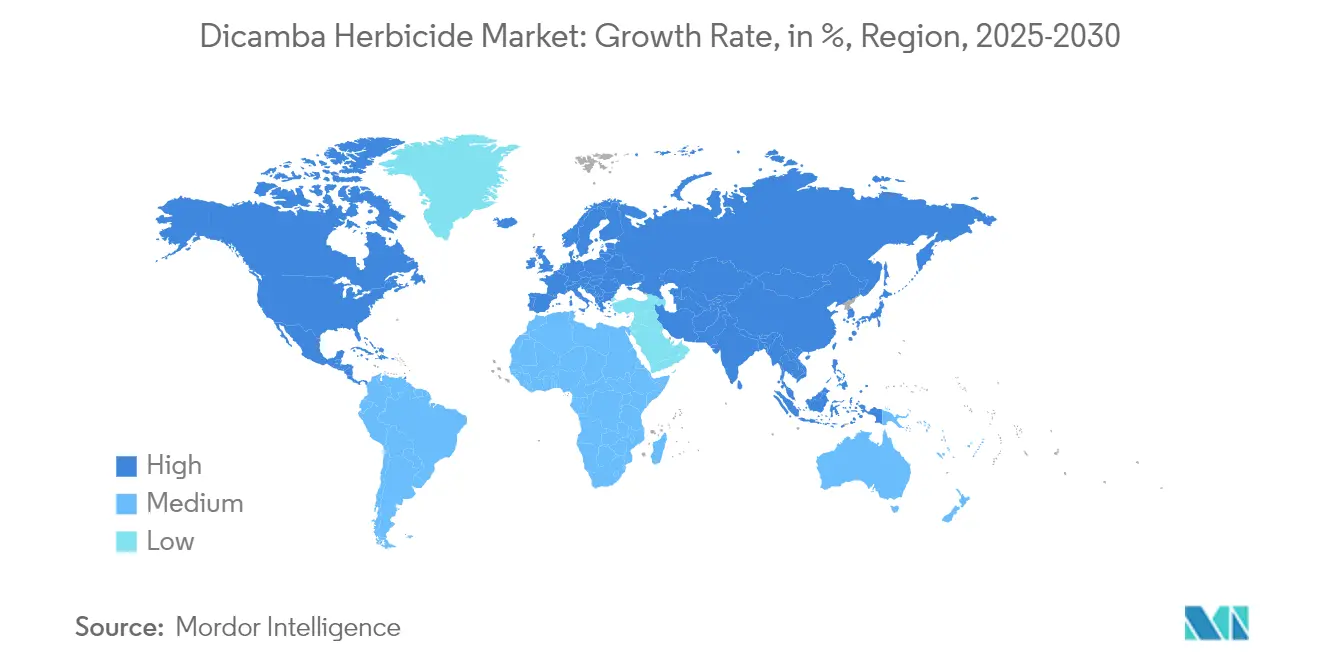
Competitive Landscape
The dicamba herbicide market exhibits a consolidated structure, with a mix of global agrochemical conglomerates and established local players competing for market share. Global players include Bayer AG, Syngenta AG, FMC Corporation, Nufarm Ltd., and BASF SE, capturing a certain portion of the market share. Companies are increasingly focusing on vertical integration, from research and development to manufacturing and distribution, to maintain competitive advantages. Local players are strengthening their position through investments in manufacturing capabilities and expanding their product portfolios, while global players are establishing research centers and production facilities in India to enhance their local presence and market understanding.
Dicamba Herbicide Industry Leaders
-
Bayer AG
-
Syngenta AG
-
FMC Corporation
-
BASF SE
-
Nufarm Ltd.
- *Disclaimer: Major Players sorted in no particular order
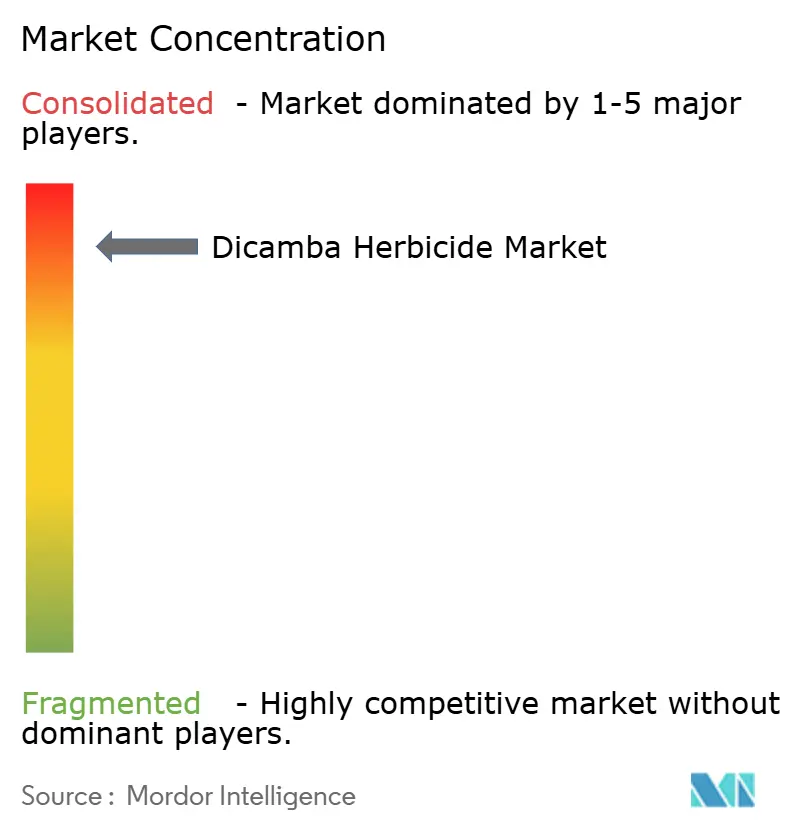
Recent Industry Developments
- March 2025: Nufarm Ltd. registered Weedar XHL and WeedMaster XHL herbicides, which feature the company's patented 2,4-D Dual Salt Technology. WeedMaster XHL combines dual-salt 2,4-D with DGA dicamba, offering reduced volatility compared to traditional DMA dicamba and controlling more than 90 weed and brush varieties. Weedar XHL is approved for use in over 25 crops, including cereals, corn, soybeans, fallow land, pastures, and rangeland.
- July 2024: Syngenta AG submitted a proposed label for a new herbicide formulation containing dicamba and S-metolachlor. The company is the third manufacturer seeking registration for a dicamba-based product following the vacatur of existing labels earlier this year.
Global Dicamba Herbicide Market Report Scope
Dicamba is a selective herbicide that controls annual, biennial, and perennial broadleaf weeds across various agricultural crops. The Dicamba herbicide market is segmented by Form (Dry and Liquid), Application (Grains and Cereals, Oil Seeds and Pulses, Fruits and Vegetables, Commercial Crops, Turfs and Ornaments), and Geography (North America, Europe, Asia-Pacific, South America, Middle East and Africa). The report offers market size and forecasts in terms of value (USD) for all the above segments.
| Liquid |
| Dry |
| Grains and Cereals |
| Oil Seeds and Pulses |
| Fruits and Vegetables |
| Commercial Crops |
| Turfs and Ornaments |
| North America | United States |
| Canada | |
| Mexico | |
| Rest of North America | |
| Europe | Spain |
| United Kingdom | |
| Germany | |
| France | |
| Italy | |
| Russia | |
| Rest of Europe | |
| Asia Pacific | China |
| Japan | |
| India | |
| Australia | |
| Rest of Asia-Pacific | |
| South America | Brazil |
| Argentina | |
| Rest of South America | |
| Middle East and Africa | South Africa |
| United Arab Emirates | |
| Rest of Middle East and Africa |
| Form | Liquid | |
| Dry | ||
| Application | Grains and Cereals | |
| Oil Seeds and Pulses | ||
| Fruits and Vegetables | ||
| Commercial Crops | ||
| Turfs and Ornaments | ||
| Geography | North America | United States |
| Canada | ||
| Mexico | ||
| Rest of North America | ||
| Europe | Spain | |
| United Kingdom | ||
| Germany | ||
| France | ||
| Italy | ||
| Russia | ||
| Rest of Europe | ||
| Asia Pacific | China | |
| Japan | ||
| India | ||
| Australia | ||
| Rest of Asia-Pacific | ||
| South America | Brazil | |
| Argentina | ||
| Rest of South America | ||
| Middle East and Africa | South Africa | |
| United Arab Emirates | ||
| Rest of Middle East and Africa | ||
Key Questions Answered in the Report
How big is the Dicamba Herbicide Market?
The Dicamba Herbicide Market size is expected to reach USD 561.80 million in 2025 and grow at a CAGR of 6.5% to reach USD 769.70 million by 2030.
What is the current Dicamba Herbicide Market size?
In 2025, the Dicamba Herbicide Market size is expected to reach USD 561.80 million.
Who are the key players in Dicamba Herbicide Market?
Bayer AG, Syngenta AG, FMC Corporation, BASF SE and Nufarm Ltd. are the major companies operating in the Dicamba Herbicide Market.
Which is the fastest growing region in Dicamba Herbicide Market?
Europe is estimated to grow at the highest CAGR over the forecast period (2025-2030).
Which region has the biggest share in Dicamba Herbicide Market?
In 2025, the North America accounts for the largest market share in Dicamba Herbicide Market.
What years does this Dicamba Herbicide Market cover, and what was the market size in 2024?
In 2024, the Dicamba Herbicide Market size was estimated at USD 525.28 million. The report covers the Dicamba Herbicide Market historical market size for years: 2020, 2021, 2022, 2023 and 2024. The report also forecasts the Dicamba Herbicide Market size for years: 2025, 2026, 2027, 2028, 2029 and 2030.
Page last updated on:
Dicamba Herbicide Market Report
Statistics for the 2025 Dicamba Herbicide market share, size and revenue growth rate, created by Mordor Intelligence™ Industry Reports. Dicamba Herbicide analysis includes a market forecast outlook for 2025 to 2030 and historical overview. Get a sample of this industry analysis as a free report PDF download.
